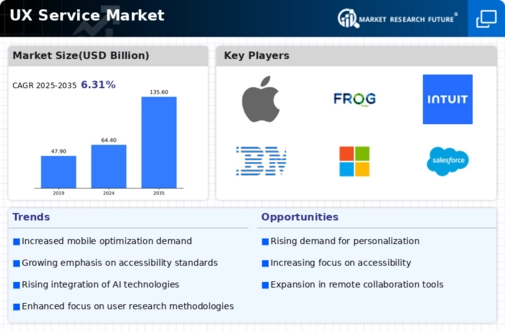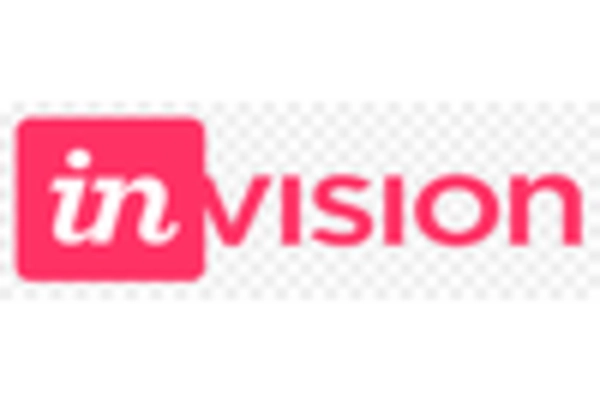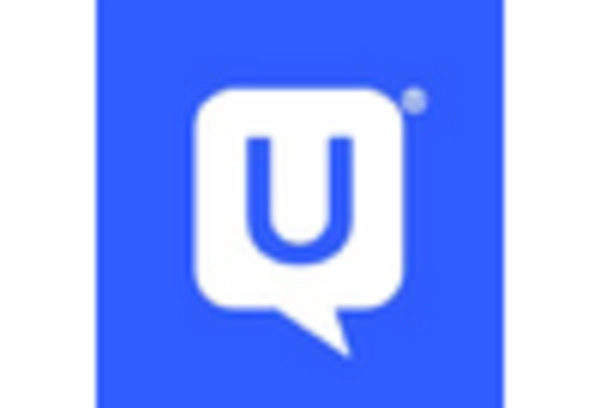Rise of Mobile and Multi-Device Usage
The proliferation of mobile devices and the increasing use of multiple platforms have significantly impacted the UX Service Market. As users engage with brands across various devices, the need for seamless and consistent user experiences has become paramount. Recent statistics reveal that mobile devices account for over 50% of web traffic, highlighting the necessity for responsive design. UX service providers are now tasked with ensuring that interfaces are optimized for both mobile and desktop environments. This trend not only enhances user satisfaction but also broadens the reach of businesses, as a well-designed multi-device experience can attract a diverse audience. The UX Service Market is thus evolving to meet these demands, with a focus on cross-platform compatibility and user-centric design principles.
Focus on Accessibility and Inclusive Design
The emphasis on accessibility and inclusive design is becoming a pivotal driver in the UX Service Market. As awareness of diverse user needs grows, businesses are increasingly prioritizing designs that cater to individuals with disabilities. Recent studies indicate that companies that adopt inclusive design principles can tap into a market segment that represents over one billion people worldwide. This focus on accessibility not only fulfills legal requirements but also enhances brand reputation and customer loyalty. UX service providers are now tasked with creating interfaces that are usable by everyone, regardless of their abilities. The commitment to inclusive design is likely to shape the future of the UX Service Market, as organizations recognize the value of reaching a broader audience through thoughtful and accessible design solutions.
Growing Demand for Personalized Experiences
The UX Service Market is witnessing a pronounced shift towards personalized user experiences. As consumers increasingly seek tailored interactions, businesses are compelled to adapt their digital interfaces accordingly. This trend is underscored by data indicating that 80% of consumers are more likely to make a purchase when brands offer personalized experiences. Consequently, UX service providers are focusing on user research and data analytics to create customized solutions. This growing demand for personalization not only enhances user satisfaction but also drives customer loyalty, thereby propelling the UX Service Market forward. Companies that prioritize personalized design are likely to see improved engagement metrics, which can translate into higher conversion rates and increased revenue.
Increased Investment in UX Research and Testing
Investment in UX research and testing is becoming a critical driver within the UX Service Market. Companies are recognizing that understanding user behavior and preferences is essential for creating effective digital products. Data suggests that organizations that prioritize UX research are 2.5 times more likely to see a return on investment. This trend has led to a surge in demand for UX service providers who specialize in user testing, usability studies, and iterative design processes. By investing in comprehensive research methodologies, businesses can identify pain points and optimize their offerings, ultimately leading to enhanced user experiences. The emphasis on research-driven design is likely to continue shaping the UX Service Market, as companies strive to create products that resonate with their target audiences.
Emergence of Artificial Intelligence in UX Design
The integration of artificial intelligence (AI) into UX design is emerging as a transformative force within the UX Service Market. AI technologies are enabling designers to analyze user data more effectively, predict user behavior, and automate design processes. This shift is evidenced by the increasing adoption of AI-driven tools that enhance user experience through personalization and adaptive interfaces. As businesses seek to leverage AI capabilities, the demand for UX services that incorporate these technologies is likely to rise. The potential for AI to streamline design workflows and improve user engagement presents a compelling opportunity for UX service providers. Consequently, the UX Service Market is poised for growth as organizations embrace AI to create innovative and user-friendly digital experiences.


















Leave a Comment